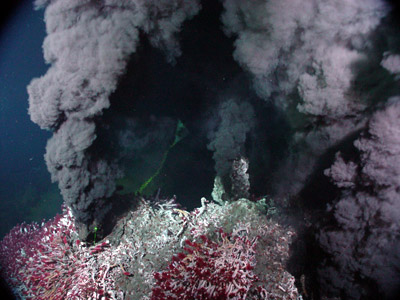Supercritical water or hydrothermal water is found several kilometers below the earth's surface when the pressure of the overlaying rocks exceeds 220 times more than the atmospheric pressure at sea level as well as elevated temperatures up to 600°C. Water at this temperature is considered supercritical and does not behave like ordinary water; at this temperature water is capable of dissolving most minerals in the surrounding rock including gold.
You could liken supercritical water to water that has been heated in a pressure cooker except it reaches far higher temperatures and pressures than can be reached on your kitchen stove. At these extreme pressures and temperatures the water ceases to act like ordinary water instead it becomes far less dense than water and capable of going places where ordinary water can't go. At the same time it is also capable of carrying large amounts of dissolved minerals that are carried essentially upwards until they reach a place where the temperature or pressure has dropped enough to cause their precipitation.
Another cause of this precipitation is if the mineral charged waters strike a type of rock such as limestone or quartzite that causes a reaction with the supercritical water causing certain minerals to fall out of solution. It is supercritical water that is the driving force behind metamorphism and all its processes.
 |
| Gold in Quartz from Jamestown District, Boulder County, Colorado Photo by Rob Lavinsky |
Generally supercritical water works with carbon dioxide and sulfur that also create large deposits of metallic sulfides that are termed Volcanogenic Massive Sulfides (VMS). In very deep water such as that found in the deeper parts of the ocean supercritical water can be exhausted into the open water where it precipitates large clouds of metallic sulfides in a feature that scientists call “Black Smokers”
Most of the gold this precipitation by supercritical water is between 100° and 200°C that is about the temperature at which the metamorphic rock slate normally forms. The gold is often found in quartz veins that intrude the beds of Slate.
Another type of gold deposit that can occur as a result of being precipitated from supercritical water is the so-called Carlin type of ore deposit where the gold is disseminated through the rock in specs so tiny they can only be seen with an electron microscope and may consist of this little is one ion of gold.
A similar situation is found in quartzite that has been stained by supercritical water passing through the sandstone in leaving behind a whole suite of minerals that can very often not be seen to the naked eye. This is especially true if the quartzite shows any form of yellow or even better green staining.
 |
| Black Smoker with clouds of metal sulfides surrounded by supercritical water NOAA |
If you are finding classy looking quartzite without any staining at all you can be almost sure that it is barren of any mineralization including gold. One of the things you should examine further is any quartzite that has been stained yellow or green. This is especially true if the quartzite is in a contact deposit close to an igneous intrusion where often form a halo around the intrusion. This type of deposit is called a skarn that can contain all kinds of mineralization including gold.

Bullion Exchanges is a well known Bullion Seller located in New York City's Diamond District.
ReplyDeleteThey have a large selection of items including but not limited to, precious metals that range from the gold & silver to the newly emerging platinum & palladium.
Bullion Exchanges are offering an enormous range of products appealing to first time buyers and the established investors.